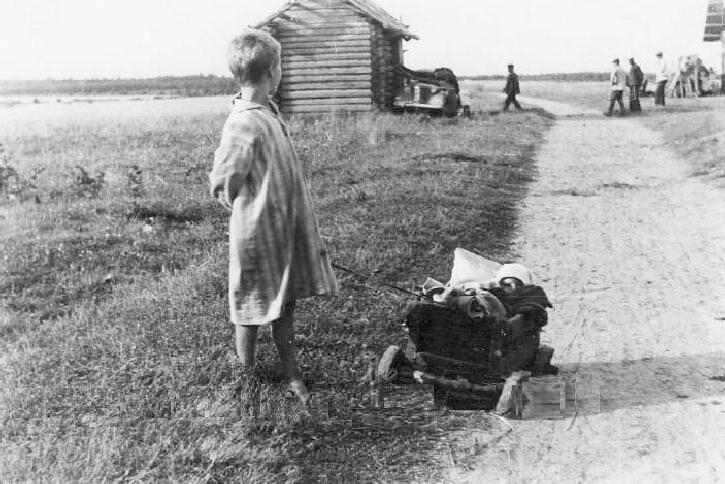
Operation Barbarossa: The Soviet Battlefield

Figure 1.--Unlike Western Europr the Soviet Union had an extremely primitive road system. As the Wehrmacht pressed deeper into the Soviet Union, keeping front line units supplied became an increasingly difficult problem. The road here was by no means the worst roads the Whrmacht encountered. You can imagine when the Autumn fall rains brgan what heavy vehicles would do to unimproved roads like this. YThis photograph was taken by a German soldier. Note the Wehrmacht staff car by the hut.
|
|
The Soviet Union presented the Wehrmacht with a battlefield unlike anything it had experienced in Poland or Westrern Europe. Large areas of the western Soviet Union presented the Germans with flat terraine--perfect tank country. Everything about the Soviet Union was different, howver, than the small countries of Western Europe. The Wehrmacht rapidly penetrated deep into the country and thus were fighting at great distances from the Reich. Logistics thus became an increasing problem the furthur the Wehrmacht moved East. And unlike Western Europr the Soviet Union had an extremely primitive road system. Luftwaffe penetrated into the Soviet Union. The Luftwaffe could no longer operate from well prepare fields. The Panzers no longer were ooerating on modern roads. Maps were not available and those that existed were often out of date or inaccurate. The Germans began to encounter major rivers that they were unfamiliar or totally unknown. And the size of the battlefield made it difficult to amass forces capable of destroying the Red Army as they had the smaller adverseries in the west. The Wehrmacht was experiencing significan problems well before the October rains and November frost. There were few signs in the Soviet roads which were often unimproved waggon tracks which had a way of just running out. One German officer trying to cross a swap found that the roads simoly ran out. He writes, The occupants of the wretched huts , which we came across here and there, apparently equally bewildered when we requested them to make a circle around the swapy area and lead us to a village that was marked on our obsolete maps as being located on our line of march. These people were not familar with the names with which the village was labeled on our maps, because the name had been changed decades earlier. Often we were relying soley on our compasses and our instincts." [Raus, p. 46.]
Sources
Citino, Robert M. The German Way of War: From the Thirty Years' War to the Third Reich (Lawrence: Kansas University Press, 2005), 428p.
Raus, Erhard. Panzer Operations: The Eastern Front Memoir of Erhard Raus, 1941-45 (New York: Da Capo, 2003).
HBC

Navigate the Boys' Historical Clothing Web Site:
[Return to Main Barbarossa battelfields]
[Return to Main Barbarossa page]
[Return to Main German World War II page]
[Return to World War II First phase campaign page]
[Introduction]
[Activities]
[Biographies]
[Chronology]
[Clothing styles]
[Countries]
[Bibliographies]
[Contributions]
[FAQs]
[Glossaries]
[Images]
[Links]
[Registration]
[Tools]
[Boys' Clothing Home]
Created: 3:54 AM 8/16/2008
Last updated: 4:58 PM 11/1/2008



